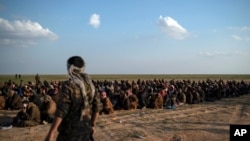Kurdish military officials in Syria say the Islamic State continues to pose a threat to regional and global security, despite major gains made against the terror group.
In an interview with VOA’s Kurdish service Thursday, Mazloum Abdi, general commander of Syrian Democratic Forces (SDF), said while IS no longer controls any territory in the region, “the terror organization is trying to revive itself.”
The SDF, a Kurdish-led military alliance, has been a major U.S. partner in the fight against IS, also known as ISIS.
“ISIS is not finished yet,” Abdi said, adding that the group “has recently intensified its attacks” in northeast Syria.
In recent weeks, the SDF has carried out several raids against IS cells in eastern Syria following a surge in attacks claimed by IS against civilians and SDF personnel in the restive region. The U.S.-led coalition has provided support in recent SDF operations against the terror group.
IS was declared defeated militarily in March 2019 after a U.S.-led campaign that destroyed its so-called caliphate in eastern Syria. But the extremist group has since continued to wage deadly attacks throughout Iraq and Syria.
Abdi claimed that IS militants continue to infiltrate SDF-held territory from areas controlled by the government of Syrian President Bashar al-Assad and by the Iraqi government.
“With our allies in the Coalition under U.S. leadership, our operations against ISIS sleeper cells are moving forward successfully,” he added, using another name for the Islamic State.
The U.S. currently has about 700 troops in the region as part of a global coalition against the terror group.
Last week, Col. Wayne Marotto, spokesman for the U.S.-led coalition, said their mission in northeast Syria has not changed.
“The Coalition works by, with and through our partner force SDF to defeat Daesh,” he said on Twitter, using an Arabic acronym for IS.
“The coalition regularly conducts security patrols; resupply convoys into the ESSA [Eastern Syria Security Area] … and maintains bases.”
In its quarterly report released in February, the U.S. Defense Department’s Office of Inspector General said that “ISIS remained a cohesive organization and continued to operate as a low-level insurgency in Iraq and Syria. Its strategy, capabilities, and group cohesion remained largely unchanged.”
“Over the last year, the situation in Iraq and Syria has settled into a status quo where local partner forces, with Coalition support, are preventing ISIS from resurging, but are unable to degrade ISIS further to the point that it no longer poses a threat,” Sean O’Donnell, Acting Inspector General, said in the report.
“This status quo is due to a number of factors that Coalition and partner forces cannot address by military means alone,” he said.
In Syria, SDF’s Abdi offered a way to address these challenges.
“To prevent an ISIS comeback, we urgently need to clarify the future political status of this region,” he said, urging the coalition to “continue their work in the areas liberated from ISIS.”
“If they provide support for the civilian administration in our region, we can pursue a more effective campaign against ISIS,” Abdi added.




